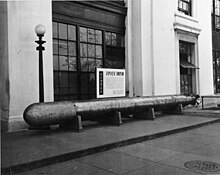Type 93 torpedo
| Type 93 torpedo | |
|---|---|

Type 93 torpedo, recovered from Point Cruz, Guadalcanal, on display outside U.S. Navy headquarters in Washington, D.C., during World War II.
|
|
| Type | Torpedo |
| Place of origin | Empire of Japan |
| Service history | |
| In service | 1933–1945 |
| Used by | Imperial Japanese Navy |
| Wars | Second World War |
| Production history | |
| Designer | Rear Admiral Kaneji Kishimoto and Captain Toshihide Asakuma |
| Designed | 1928–1933 |
| Variants | Type 97 torpedo, Type 95 torpedo |
| Specifications | |
| Weight | 2.7 tonnes (5952.48 lb) |
| Length | 9 metres (29 ft 6 5⁄16 in) |
| Diameter | 610 mm (2 ft 1⁄64 in) |
|
|
|
| Effective firing range | 22,000 metres (at 48–50 knots (89–93 km/h; 55–58 mph)) |
| Maximum firing range | 40,400 metres (at 34–36 knots (63–67 km/h; 39–41 mph)) |
| Warhead weight | 490 kg (1080.27 lb) |
|
|
|
| Propellant | Oxygen-enriched air |
| Speed | 52 knots (96 km/h; 60 mph) |
|
Launch
platform |
Surface ships |
The Type 93 (九三式魚雷?, designated for Imperial Japanese calendar year 2593) was a 61 cm (24 in)-diameter torpedo of the Imperial Japanese Navy (IJN), launched from surface ships. It is commonly referred to as the Long Lance by most modern English-language naval historians, a nickname given it after the war by Samuel Eliot Morison, the chief historian of the U.S. Navy, who spent much of the war in the Pacific Theater. In Japanese references, the term Sanso gyorai (酸素魚雷?, lit. "oxygen torpedo") is also used, in reference to its propulsion system. It was the most advanced naval torpedo in the world at the time.
The Type 93's development (in parallel with a submarine model, the Type 95) began in Japan in 1928, under the auspices of Rear Admiral Kaneji Kishimoto and Captain Toshihide Asakuma. The torpedo design was inspired by the British oxygen-enriched torpedoes used on the Nelson-class battleships. At the time, the most powerful potential enemy of the Japanese Navy was the United States Navy's Pacific Fleet. The U.S. Navy's doctrine, presuming an invasion by Japan of the Philippines (an American commonwealth at that time), called for the battle line to fight its way across the Pacific Ocean, relieve or recapture the Philippines, and destroy the Japanese fleet. Since the IJN had fewer battleships than the U.S. Navy, it planned to use light forces (light cruisers, destroyers, and submarines) to whittle down the U.S. Navy's fleet in a succession of minor battles, mostly at night. After the number of American warships was sufficiently reduced, IJN would commit its own presumably fresh and undamaged battleships to finish off the U.S. remnants in one huge climactic battle. (This was essentially what the U.S. Navy's "War Plan Orange" expected.)
...
Wikipedia
